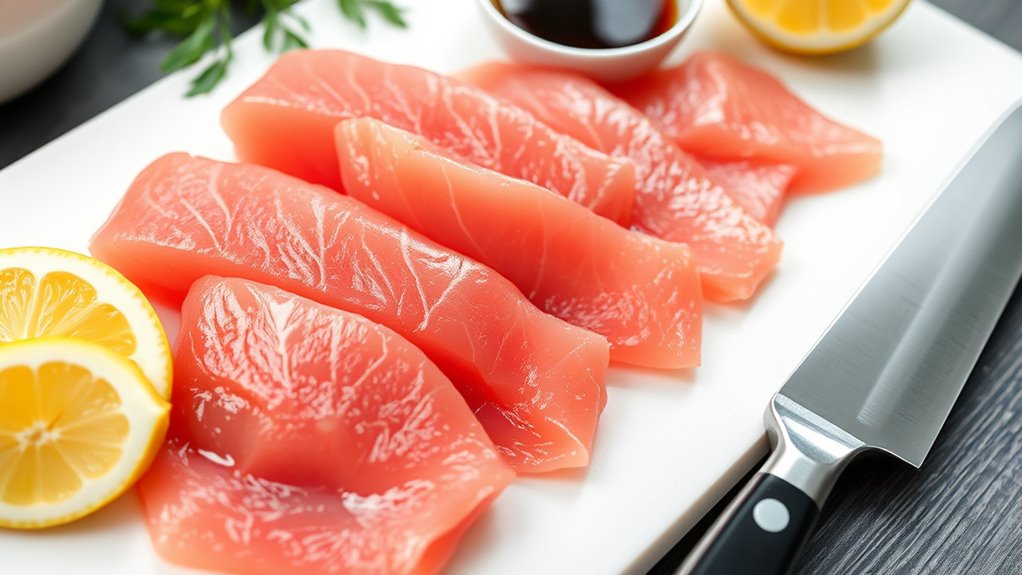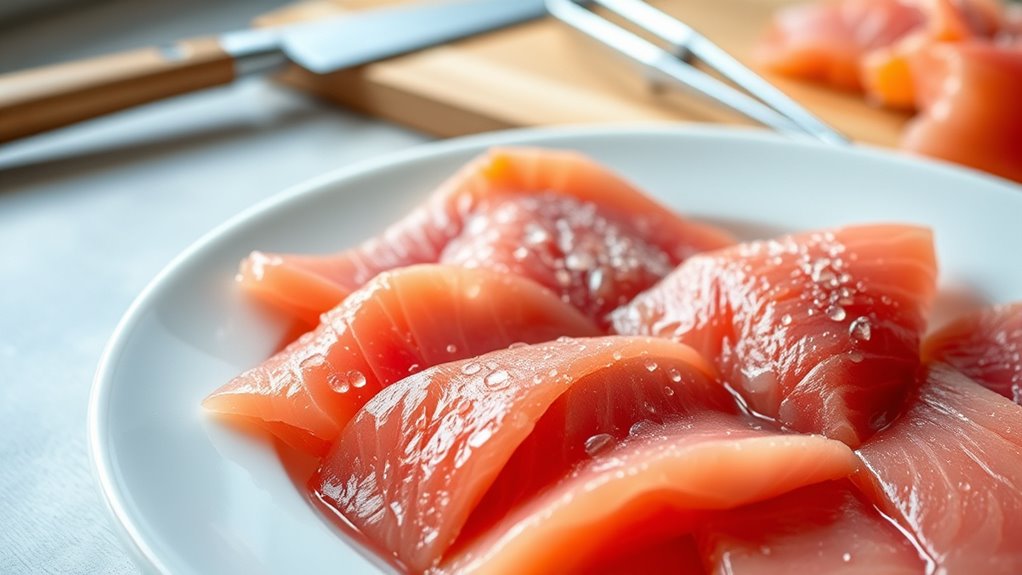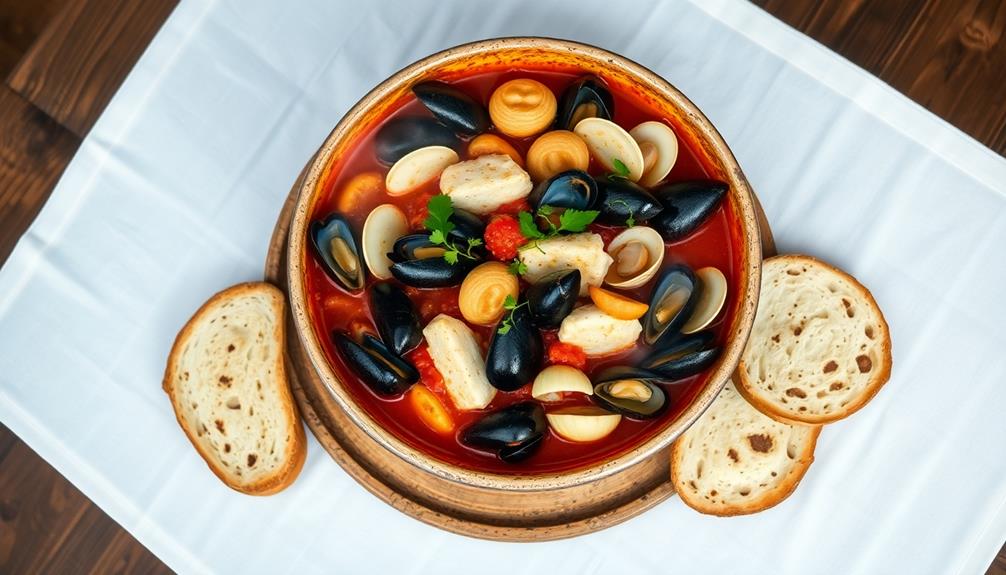To handle raw seafood safely at home for sushi, start by buying fish that is firm, clear-eyed, and has a fresh ocean scent. Always store your fish on ice or in the coldest part of your fridge immediately after purchase. Use a sharp knife and sanitize your workspace and tools to prevent cross-contamination. Keep sliced fish refrigerated until serving, and discard any fish showing signs of spoilage. Following these steps helps make certain your sushi is safe and delicious—discover more tips to perfect your process.
Key Takeaways
- Always buy seafood from reputable sources ensuring freshness and proper storage conditions.
- Keep raw fish refrigerated at the coldest part or on ice until ready to prepare.
- Use a sanitized, sharp knife and work on clean surfaces to prevent cross-contamination.
- Wash hands thoroughly before handling seafood and after touching raw fish.
- Consume or store prepared sushi promptly, keeping it refrigerated and covered to prevent bacterial growth.

Handling raw seafood for sushi at home requires careful attention to cleanliness and proper storage to guarantee safety and quality. The first step is ensuring fish freshness. Fresh fish not only tastes better but also minimizes the risk of foodborne illness. When selecting your seafood, look for firm flesh that springs back when pressed, clear and bright eyes, and a clean, ocean-like smell. Avoid any fish that appears dull, slimy, or has an off-putting odor. Keeping your fish cold is essential—store it in the coldest part of your refrigerator or on ice until you’re ready to prepare it. Proper storage prevents bacterial growth and maintains its quality.
Ensure fish freshness with firm flesh, bright eyes, and ocean-like smell for safe, high-quality sushi at home.
When it’s time to prepare your seafood, your knife techniques play a key role. Using the right knife and proper cutting methods preserve the fish’s texture and guarantee safety. A sharp, well-maintained knife allows for clean cuts, reducing the risk of tearing the flesh or creating jagged edges that can harbor bacteria. When slicing your fish, hold it firmly with your non-dominant hand, making sure your fingers are tucked inward to avoid accidental cuts. Use smooth, deliberate strokes, angling the knife at approximately 45 degrees to achieve thin, even slices. This technique not only improves presentation but also ensures even cooking or serving. Proper knife skills help you minimize waste and avoid damaging the delicate flesh, which can compromise freshness and safety.
Additionally, always work on a sanitized cutting surface and keep your tools clean between tasks. Wash your hands thoroughly before handling the seafood to prevent cross-contamination. After slicing, inspect your fish for any signs of spoilage, such as discoloration or a slimy texture. If anything seems off, discard the fish rather than risking illness. When storing your prepared seafood, keep it refrigerated and covered, ideally on a bed of ice, if you plan to serve it later. proper refrigeration techniques help maintain the integrity and safety of your seafood longer. Ensuring your workspace is clean and sanitized is crucial for preventing contamination and ensuring food safety. Remember, food safety is a shared responsibility, and paying attention to these details can significantly reduce risks.
Handling raw seafood with care is essential for a safe and delicious sushi experience. By prioritizing fish freshness, employing proper knife techniques, and maintaining cleanliness throughout, you guarantee your home sushi is not only tasty but also safe to enjoy. Pay attention to these details, and you’ll be well on your way to mastering safe sushi preparation in your own kitchen.
Frequently Asked Questions
How Do I Identify Fresh, High-Quality Raw Seafood for Sushi?
When choosing raw seafood for sushi, focus on seafood sourcing and quality indicators. Look for vibrant, firm flesh that smells fresh and ocean-like, not fishy. Check that the eyes of whole fish are clear, and the gills are bright red. Always buy from reputable suppliers who prioritize freshness and proper storage. Your careful selection guarantees your sushi is both delicious and safe to enjoy.
What Are the Best Storage Methods for Raw Seafood Before Preparation?
They say “a stitch in time saves nine,” and the same applies to storing raw seafood. To keep it fresh before prep, use proper refrigeration—set your fridge to 32°F (0°C)—and store the seafood in airtight packaging. This prevents cross-contamination and preserves quality. Keep it on the coldest shelf and consume within 1-2 days. Proper storage guarantees your sushi turns out delicious and safe to eat.
Can I Freeze Raw Seafood Safely for Later Sushi Use?
Yes, you can freeze raw seafood safely for later sushi use. Use proper freezing techniques like vacuum sealing or airtight containers to prevent freezer burn. When you’re ready to prepare, follow safe seafood thawing practices by thawing slowly in the refrigerator or under cold running water. This guarantees your seafood remains fresh and safe, maintaining quality for sushi preparation without risking contamination.
Are There Specific Hygiene Practices to Prevent Cross-Contamination?
Think of your kitchen as a battlefield against cross-contamination. You wield proper handwashing like a shield, keeping germs at bay, and sanitized utensils as your weapons, ensuring no unwanted guests hitch a ride on your raw seafood. By maintaining strict hygiene practices, you create a safe environment where your sushi can shine without worry. Stay vigilant, wash thoroughly, and sanitize often—your taste buds and health will thank you.
How Do I Tell if Raw Seafood Has Gone Bad?
To tell if raw seafood has gone bad, start by smelling it; a fishy smell is normal, but a strong, sour, or ammonia-like odor indicates spoilage. Check the texture—if it’s slimy or sticky, it’s likely spoiled. Also, look for discoloration or any unusual spots. Fresh seafood should look firm and shiny. When in doubt, it’s safest to discard it to avoid health risks.
Conclusion
Now that you know the ins and outs of handling raw seafood, you’re all set to enjoy sushi safely at home. Just remember, practice makes perfect, and patience is key. Keep everything chilled, work clean, and trust your instincts. When you do, you’ll see that safe sushi isn’t just a goal—it’s a journey worth taking. With care and attention, you’ll be rolling like a pro in no time.










